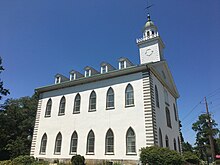
Back Kirtlandský chrám Czech Kirtland-Tempel German Templo de Kirtland Esperanto Templo de Kirtland Spanish Templo Mormona en Kirtland IO Templo de Kirtland MWL Świątynia Kirtland Polish Templo de Kirtland Portuguese Kirtlandský chrám Slovak 嘉德蘭聖殿 Chinese
| Kirtland Temple | ||||
|---|---|---|---|---|
| Historic site | ||||
 | ||||
 | ||||
| Dedication | March 27, 1836, by Joseph Smith | |||
| Site | 5.8 acres (2.3 ha) | |||
| Floor area | 15,000 sq ft (1,400 m2) | |||
| • News & images | ||||
| ||||
| Additional information | ||||
| Announced | December 27, 1832, by Joseph Smith | |||
| Groundbreaking | June 5, 1833 | |||
| Location | Kirtland, Ohio, United States | |||
| Geographic coordinates | 41°37′31″N 81°21′44″W / 41.62528°N 81.36222°W | |||
| Exterior finish | Sandstone and stucco | |||
| Temple design | Federal Georgian and New England Colonial | |||
| Notes | Community of Christ-owned until March 5, 2024. The Church of Jesus Christ of Latter-day Saints-owned since March 5, 2024. | |||
| () | ||||
Kirtland Temple | |
| Location | Kirtland, Ohio |
|---|---|
| Coordinates | 41°37′31″N 81°21′44″W / 41.62528°N 81.36222°W |
| Built | 1833 |
| Architect | Smith, Joseph; Et al. |
| Architectural style | Gothic, Federal |
| NRHP reference No. | 69000145[1] |
| Added to NRHP | June 4, 1969 |
The Kirtland Temple is the first temple built by adherents of the Latter Day Saint movement, located in Kirtland, Ohio, and dedicated in March 1836. Joseph Smith, the movement's founder, directed the construction following a series of reported revelations, and the temple showcases a blend of Federal, Greek Revival, and Gothic Revival architectural styles.[2] It was added to the National Register of Historic Places in 1969 and named a National Historic Landmark in 1977. Prior to March 5, 2024, the temple was owned and operated by Community of Christ (previously known as the Reorganized Church of Jesus Christ of Latter Day Saints (RLDS)) for over a century before ownership transferred to the Church of Jesus Christ of Latter-day Saints (LDS Church).
Construction of the Kirtland Temple was a community effort involving significant contributions from church members, including the establishment of a sawmill and an ashery to supply building materials. The temple features unique architectural elements such as adjustable pews and dual pulpits, reflecting its multifunctional use for worship and education. The third floor was used for academic and religious instruction, emphasizing the importance of Hebrew studies to the faith's theological development.
The dedication on March 27, 1836, was attended by approximately one thousand people and included traditional rites such as the Hosanna Shout. Reports of visions and spiritual experiences by church leaders, including the restoration of certain priesthood keys through ancient prophets Moses, Elias (understood to be the Biblical prophet Malachi), and Elijah, were documented and later canonized in the Doctrine and Covenants. These keys represented various aspects of religious authority, including the gathering of Israel, the gospel of Abraham, and sealing powers. Not long after the dedication, Joseph Smith and Oliver Cowdery reported seeing Jesus Christ "standing upon the breastwork of the pulpit."
Throughout its history, the Kirtland Temple has undergone various ownership changes and legal disputes, ultimately maintaining its status as a place of worship and historical significance within the Latter Day Saint movement. Today, it continues to serve as a historic site, open year-round for guided tours, meetings, and events, attracting visitors from around the world, and around 100,000 visitors annually. The temple's rich history, architectural distinctiveness, and ongoing religious and community use make it a unique landmark in American religious history.
- ^ "National Register Information System". National Register of Historic Places. National Park Service. January 23, 2007.
- ^ Chiat, Marilyn, North American Churches, Publishers International, Ltd.: 2004, p. 71.

